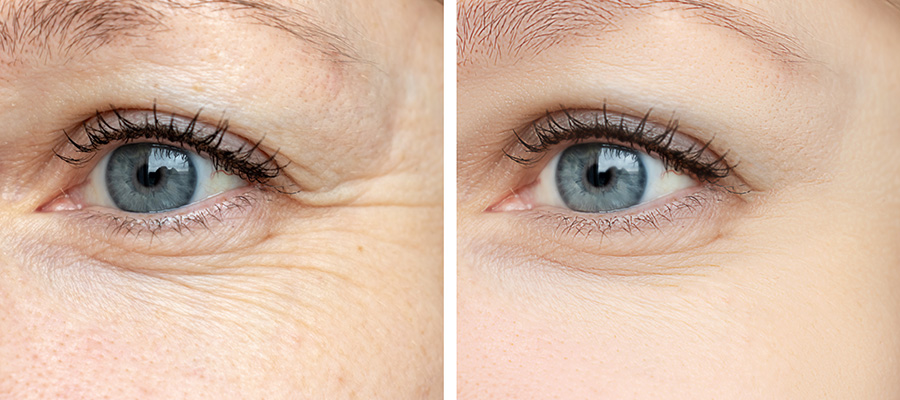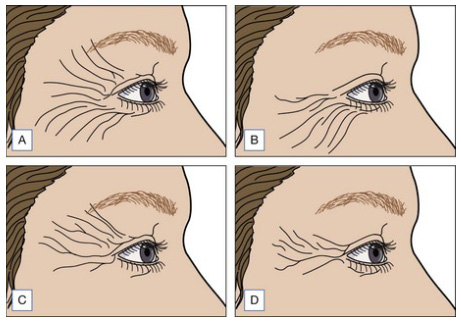
The Crow’s feet are wrinkles which form around the corners of your eyes and are a characteristic of the aging face. These wrinkles occur as a result of contraction by the orbicularis oculi muscle. Crow’s feet are noteworthy on older individuals because the aging process around the eyelids leads to volume loss and excessive skin elasticity. In many cases, volume loss also leads to the eyes appearing hollowed-out or sunken, surrounded by dark circles under the eyes. Crow’s feet forming on the outside of the eyelids have been extensively studied and can be classified into 4 different patterns which will require different treatment approaches.
Previous research has demonstrated the wrinkles in the lateral portions of the eyelid can be classified into four types, which reflect the different types of muscle contraction patterns:
A. Full fan shaped wrinkles from the corner of the eyelid and extending into the upper eyelids and to the upper cheeks.
B. Wrinkles from the corner of the eyelid which extend lower eyelid and into the upper cheek.
C. Wrinkles which begin at the corner of the eyelid and extend into the upper eyelid heading towards the temples.
D. A central zone of wrinkles which begin at the corner of the eyelid and extend directly backwards.

Dynamic Versus Static Lines and Wrinkles.
In most patients seen at Guerra Plastic Surgery Center in Scottsdale, Arizona, the Crow’s feet lines and wrinkles come and go as the orbicular muscle contracts and relaxes – these are called Dynamic lines, which occur when the underlying muscles move. These patients are ideal candidates for a neuromuscular modulator such as BOTOX or Dysport. Neuromodulators work by preventing muscle contraction. More specifically, both BOTOX and Dysport molecules bind to high affinity recognition sites on the nerve-muscle connection and prevents the release of a messenger chemical called Acetylcholine (AcH), which activates muscle contraction, from being released. When the (AcH) release is inhibited, then muscle contraction and thus wrinkle formation is also blocked.
For some patients, the Crow’s feet lines and wrinkles are deeply set and are present even when the muscles are not activated or contracting - these are called Static Lines, and these cannot be treated effectively with BOTOX or Dysport. Static lines are present all the time. These are best treated with alternative methods such as chemical peels, dermal fillers, and Platelet Rich Fibrin (PRF) injections. It is common for patients to present with a combination of both static and dynamic lines, and additional treatments may be recommended in addition to neuromodulators.
Preventing Static Lines from becoming established is one of the top priorities of neuromodulator injections on a consistent and steady basis. It’s also why it’s never too early to start BOTOX or Dysport! Early use of neuromodulators is thought to reduce the incidence of repeated microtrauma to the skin’s collagen and elastin components of youth. It is very similar to the approach we take on avoiding unnecessary sun exposure – it should start early and occur often!
Standardized versus Individualized Approach to Crow’s Feet Wrinkles.
Standard sets of injections around the orbicular muscles are helpful, but the more experienced injectors, as in our practice, prefer a more individualized approach because the results are better and the satisfaction rate for patients is higher. Attention to detail is the key to success with BOTOX or Dysport injections anywhere on the face, but in particular the eye area.
For instance, some patients may exhibit right versus left side differences in the distribution of Crow’s feet. In fact, most individuals have a greater number of wrinkles and lines on the left side of the face, because of sun exposure while driving. The individualized approach takes into account the diversity found in Crow’s feet lines with each individual patient, and generally requires additional care and attention to more thoroughly address the patient’s specific concern.
Repeated, consistent, and long-term use of BOTOX or Dysport may actually soften some static lines as the dynamic effect of muscle contraction on the skin is constantly reduced – It also gives you all the other benefits of BOTOX and Dysport! You can have a refreshed, youthful, andt natural appearance with treatment by one of our great injectors.
One difference between BOTOX and Dysport that we ask all patients to discuss with us is the final result on the level of relaxation. It turns out that BOTOX, gives a more significantly pronounced relaxation of the facial muscles, leading to significant less facial muscle mobility after treatment – and a more fixed appearance. Dysport on the other hand, is known for good results, with a softer outcome and some mobility of expression. Patients typically prefer one neuromodulator versus another based on the how “frozen” versus how “expressive” they want to look after treatment. We are always happy to discuss this intricate detail and get the best individualized results for all our patients.
If you’re considering a Crow’s feet treatment with either BOTOX and Dysport at Guerra Plastic Surgery Center, call our office, at (480) 571-7625.